European corn borer
Ostrinia nubilalis
Appearance
The moths reach a wingspan of 28-30 mm. Their forewings are yellowish and have several shadowy serrated bands. Males are darker colored than females.
Caterpillars are initially gray in color and have a dark head. Older caterpillars are dark brown to pale red with a black head, brownish nuchal shield, and six dark brown warts on each segment - they grow up to 20 mm long.
The eggs are laid overlapping like roof tiles in groups of 15 to 35. The single egg is shield-shaped, about 1 mm in size, and whitish translucent. It is "glued" to the undersides of higher leaves of the host plants.
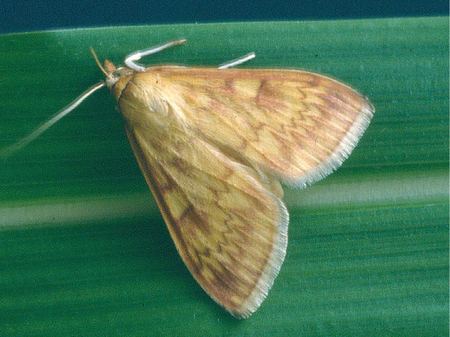
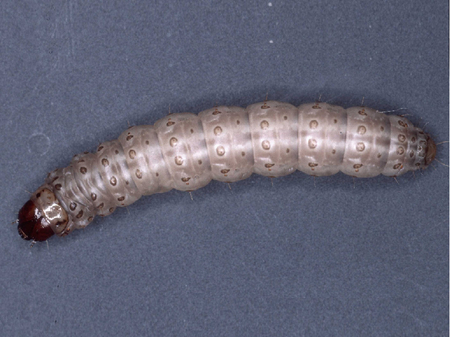
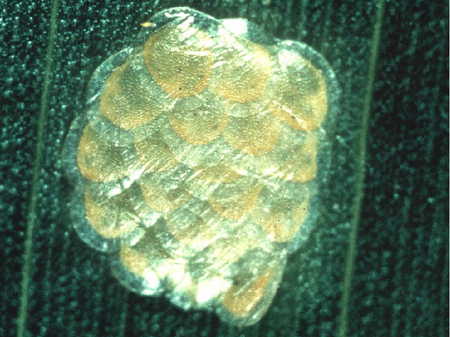
Biology
The corn borer is a small butterfly from the family of bugs (Pyralidae). Its flight period can last until the end of August, with the peak of flight in July. In Central Europe, the corn borer develops one to two generations per year, depending on the breed. In warm years, development proceeds more rapidly, favoring the development of the second generation. However, lack of rainfall has a negative impact on both corn and the corn borer. The bivoltine race (race with two generations per year) appeared for the first time in our monitoring with a notable second generation in Austria in early August 2002. In recent years, the number of corn borers caught has been subject to local fluctuations, some of which have been strong, making it impossible to derive a clear trend.
The corn borers are nocturnal and lay their eggs after mating overlapping like roof tiles in groups of 15 to 35. Most eggs are laid in July. About a week later, the caterpillar hatches and rapidly burrows into leaf veins and leaf axils. Later they mine in stems, often in the base of male flowers (flags) and in corncobs.
When the caterpillars have completed their growth, they gnaw a small chamber in the stem pith of the plants, where they spend the rest of the season and eventually overwinter. Recent studies have shown that those living on mugwort and other wild plants are of a different species than those living on corn and peppers and also differ in the composition of their pheromones. As temperatures rise in spring, the caterpillars molt into dark brown mummy pupae measuring about 17 mm. About 14 days later, the fully developed corn borer hatches beginning in early June.
Long-term gradation cycles occur, for which parasitic spore animals from the microsporidian group are thought to be responsible. These are thought to be first generation stragglers or second generation animals. Within the corn borer warning service, however, a second generation of corn borers has never been observed in Austria.
On peppers, the development looks slightly different: here, the corn borer lays its eggs only from the beginning of August, preferably near young fruits. The animals probably migrate from the corn plants, which become increasingly hard in midsummer and eventually dry up, to the still green bell pepper crops. The caterpillars bore into the gap between the calyx and the fruit in the peppers and then feed in the bell pepper fruits.
Damage symptoms
In stems, flags and cobs of maize plants, boreholes up to 6 mm wide can be found together with webs and fecal crumbs. In severe infestations, shoot tips (male flowers, flags) often break off. In the vicinity of the stem nodes, boreholes with exuding bore dust are frequently observed. Boring meal and fecal crumbs are found in bell pepper fruit, often turning to rot.
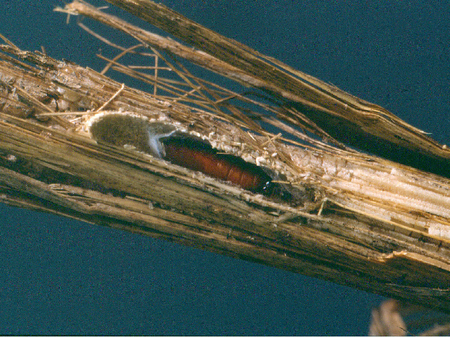
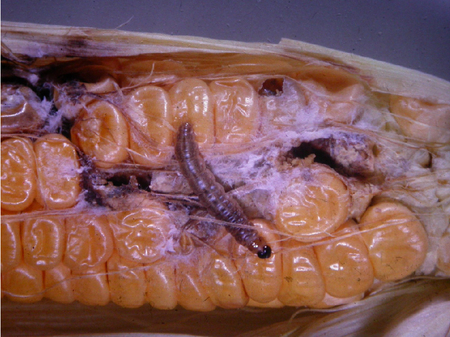
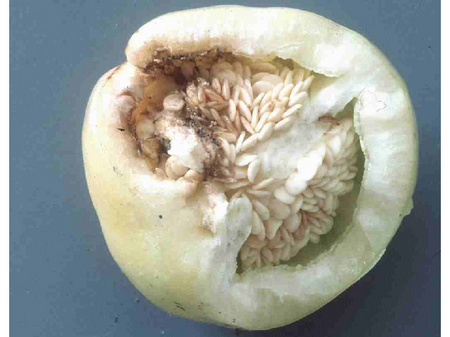
Prevention and control
- Preventive removal of all stubble residues from the field after harvest by the end of March at the latest. Corn stubble and corn straw should be plowed under so deeply that nothing can hatch from them. However, since the moths spread by flight, this measure must be carried out by all farmers in a region for successful control.
- Spray treatment with agents against corn borers at the time of maximum larval hatch (see list of plant protection products approved in Austria). This is approximately in the first half of July and is specified more precisely by correspondingwarning messages. For the control success it is important that the treatment is carried out as long as the caterpillars have not yet bored in. This can lead to problems in connection with the overlong egg-laying period. Preparations based on Bacillus thuringiensis are also effective.
Last updated: 11.12.2025
automatically translated